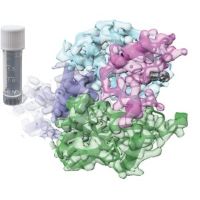Specification
| Description | Recombinant protein from the full-length sequence of homo sapiens aldo-keto reductase family 1, member C3 (AKR1C3), transcript variant 1 (NM_003739). |
| Organism | Homo sapiens (Human) |
| Expression Host | Human Cells |
| Tag Info | His or DYKDDDDK. Please contact us if you need further information or require specific designed tag. |
| Purity | Greater than 90% by SDS-PAGE gel |
| Uniprot ID | P42330 |
| Entry Name | AK1C3_HUMAN |
| Gene Names | AKR1C3 DDH1 HSD17B5 KIAA0119 PGFS |
| Alternative Gene Names | DDH1 HSD17B5 KIAA0119 PGFS |
| Alternative Protein Names | Aldo-keto reductase family 1 member C3 (EC 1.1.1.-) (EC 1.1.1.210) (EC 1.1.1.53) (EC 1.1.1.62) (17-beta-hydroxysteroid dehydrogenase type 5) (17-beta-HSD 5) (3-alpha-HSD type II, brain) (3-alpha-hydroxysteroid dehydrogenase type 2) (3-alpha-HSD type 2) (EC 1.1.1.357) (Chlordecone reductase homolog HAKRb) (Dihydrodiol dehydrogenase 3) (DD-3) (DD3) (Dihydrodiol dehydrogenase type I) (HA1753) (Prostaglandin F synthase) (PGFS) (EC 1.1.1.188) (Testosterone 17-beta-dehydrogenase 5) (EC 1.1.1.239) (EC 1.1.1.64) |
| Application | Antigens, Western, ELISA and other in vitro binding or in vivo functional assays, and protein-protein interaction studies; For research & development use only! |
| Buffer | Purified protein formulated in a sterile solution of PBS buffer, pH7.2, without any preservatives |
| Endotoxin | Endotoxin level is < 0.1 ng/µg of protein (<1EU /µg) |
| Length | 323 |
| Molecular Weight(Da) | 36853 |
| Protein Sequence | (The sequence of expressed protein may have some variation from the sequence shown below. Please contact us for the exact sequence.) MDSKHQCVKLNDGHFMPVLGFGTYAPPEVPRSKALEVTKLAIEAGFRHIDSAHLYNNEEQVGLAIRSKIADGSVKREDIFYTSKLWSTFHRPELVRPALENSLKKAQLDYVDLYLIHSPMSLKPGEELSPTDENGKVIFDIVDLCTTWEAMEKCKDAGLAKSIGVSNFNRRQLEMILNKPGLKYKPVCNQVECHPYFNRSKLLDFCKSKDIVLVAYSALGSQRDKRWVDPNSPVLLEDPVLCALAKKHKRTPALIALRYQLQRGVVVLAKSYNEQRIRQNVQVFEFQLTAEDMKAIDGLDRNLHYFNSDSFASHPNYPYSDEY |
Background
| Function | FUNCTION: Cytosolic aldo-keto reductase that catalyzes the NADH and NADPH-dependent reduction of ketosteroids to hydroxysteroids. Acts as a NAD(P)(H)-dependent 3-, 17- and 20-ketosteroid reductase on the steroid nucleus and side chain and regulates the metabolism of androgens, estrogens and progesterone (PubMed:10622721, PubMed:11165022, PubMed:7650035, PubMed:9415401, PubMed:9927279). Displays the ability to catalyze both oxidation and reduction in vitro, but most probably acts as a reductase in vivo since the oxidase activity measured in vitro is inhibited by physiological concentration of NADPH (PubMed:14672942, PubMed:11165022). Acts preferentially as a 17-ketosteroid reductase and has the highest catalytic efficiency of the AKR1C enzyme for the reduction of delta4-androstenedione to form testosterone (PubMed:20036328). Reduces prostaglandin (PG) D2 to 11beta-prostaglandin F2, progesterone to 20alpha-hydroxyprogesterone and estrone to 17beta-estradiol (PubMed:15047184, PubMed:20036328, PubMed:10622721, PubMed:11165022, PubMed:10998348, PubMed:19010934). Catalyzes the transformation of the potent androgen dihydrotestosterone (DHT) into the less active form, 5-alpha-androstan-3-alpha,17-beta-diol (3-alpha-diol) (PubMed:10998348, PubMed:14672942, PubMed:11165022, PubMed:7650035, PubMed:9415401, PubMed:10557352). Displays also retinaldehyde reductase activity toward 9-cis-retinal (PubMed:21851338). {ECO:0000269|PubMed:10557352, ECO:0000269|PubMed:10622721, ECO:0000269|PubMed:10998348, ECO:0000269|PubMed:11165022, ECO:0000269|PubMed:14672942, ECO:0000269|PubMed:15047184, ECO:0000269|PubMed:19010934, ECO:0000269|PubMed:20036328, ECO:0000269|PubMed:21851338, ECO:0000269|PubMed:7650035, ECO:0000269|PubMed:9415401, ECO:0000269|PubMed:9927279}. |
| Pathway | Steroid metabolism. |
| Protein Families | Aldo/keto reductase family |
| Tissue Specificity | Expressed in many tissues including adrenal gland, brain, kidney, liver, lung, mammary gland, placenta, small intestine, colon, spleen, prostate and testis. High expression in prostate and mammary gland. In the prostate, higher levels in epithelial cells than in stromal cells. In the brain, expressed in medulla, spinal cord, frontotemporal lobes, thalamus, subthalamic nuclei and amygdala. Weaker expression in the hippocampus, substantia nigra and caudate. {ECO:0000269|PubMed:10557352, ECO:0000269|PubMed:10622721, ECO:0000269|PubMed:11165022, ECO:0000269|PubMed:7650035, ECO:0000269|PubMed:9415401, ECO:0000269|PubMed:9927279}. |
QC Data
| Note | Please contact us for QC Data |
| Product Image (Reference Only) |  |

